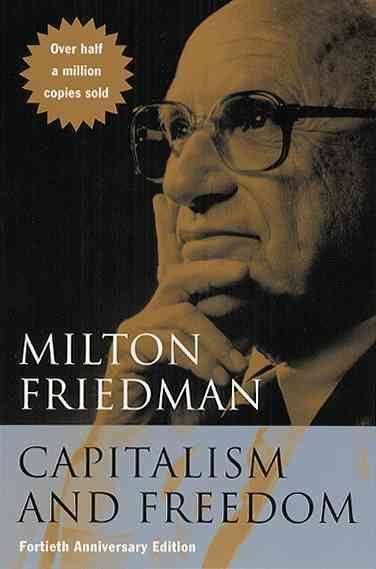7.8 /10 1 Votes7.8
Language English OCLC 49672469 Cover artist Steven N. S. Cheung | 3.9/5 Goodreads Publication date 1962 Originally published 1962 Country United States of America | |||||||||||||||||||||||||||||||||
 | ||||||||||||||||||||||||||||||||||
Media type Print (Hardback & Paperback) Pages 202 (Fortieth anniversary edition) ISBN 0-226-26421-1 (40th anniversary edition) Similar Milton Friedman books, Libertarianism books, Capitalism books | ||||||||||||||||||||||||||||||||||
Capitalism and Freedom is a book by Milton Friedman originally published in 1962 by the University of Chicago Press which discusses the role of economic capitalism in liberal society. It sold over 400,000 copies in the first eighteen years and more than half a million since 1962. It has been translated into eighteen languages. Friedman argues for economic freedom as a precondition for political freedom. He defines "liberal" in European Enlightenment terms, contrasting with an American usage that he believes has been corrupted since the Great Depression. Many North Americans usually categorized as conservative or libertarian have adopted some of his views. The book finds several realistic places in which a free market can be promoted for both philosophical and practical reasons, with several surprising conclusions. Among other concepts, Friedman advocates ending the mandatory licensing of doctors and introducing a system of vouchers for school education.
Contents
- Free to choose part 1 of 10 the power of the market featuring milton friedman
- Context
- Chapter summaries
- Influence
- References
Free to choose part 1 of 10 the power of the market featuring milton friedman
Context
Capitalism and Freedom was published nearly two decades after World War II, a time when the Great Depression was still in collective memory. Under the Kennedy and preceding Eisenhower administrations, federal expenditures were growing at a quick pace in the areas of national defense, social welfare, and infrastructure. Both major parties, Democratic and Republican, supported increased spending in different ways. This, as well as the New Deal, was supported by most intellectuals with the justification of Keynesian economics. Capitalism and Freedom introduces the idea of how competitive capitalism can help to achieve economic freedom.
Chapter summaries
Introductioni. The Relation between Economic Freedom and Political Freedomii. The Role of Government in a Free Societyiii. The Control of Moneyiv. International Financial and Trade Arrangementsv. Fiscal Policyvi. The Role of Government in Educationvii. Capitalism and Discriminationviii. Monopoly and the Social Responsibility of Business and Laborix. Occupational Licensurex. The Distribution of Incomexi. Social Welfare Measuresxii. Alleviation of Povertyxiii. ConclusionInfluence
The effects of Capitalism and Freedom were great yet varied in the realm of political economics. Some of Friedman's suggestions are being tested and implemented in many places, such as the flat income tax in Estonia (since 1994) and Slovakia (since 2004), a floating exchange rate which has almost fully replaced the Bretton Woods system, and national school voucher systems in Chile (since 1981) and Sweden (since 1992), to cite a few prominent examples. However, many other ideas have scarcely been considered, such as the end of licensing, and the abolition of corporate income tax (in favor of an income tax on the stock holder). Though politicians often claim that they are working towards "free trade," an idea the book supports, few American politicians have considered taking his suggestion of phasing out all tariffs in 10 years. Nevertheless, Friedman popularized many ideas previously unknown to most outside economics. This and other works helped Milton Friedman to become a household name. The Times Literary Supplement called it "one of the most influential books published since the war."
Capitalism and Freedom, along with many of Milton Friedman’s writing, has influenced the movement of libertarian and conservative philosophy in America. Milton’s philosophy of economic and individual freedom have pushed similar thinking political parties to emerge, such as the libertarian and tea party.
Capitalism and Freedom made the Intercollegiate Studies Institute's 50 Best Books of the Twentieth Century and also was placed tenth on the list of the 100 best non-fiction books of the twentieth century compiled by National Review. In 2011, the book was placed on Time Magazine's top 100 non-fiction books written in English since 1923.
